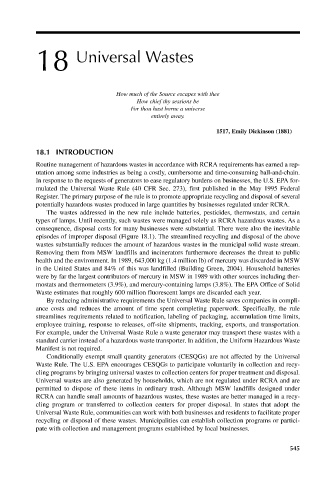Page 574 - Materials Chemistry, Second Edition
P. 574
CAT3525_C18.qxd 1/27/2005 12:47 PM Page 545
18 Universal Wastes
How much of the Source escapes with thee
How chief thy sessions be
For thou hast borne a universe
entirely away.
1517, Emily Dickinson (1881)
18.1 INTRODUCTION
Routine management of hazardous wastes in accordance with RCRA requirements has earned a rep-
utation among some industries as being a costly, cumbersome and time-consuming ball-and-chain.
In response to the requests of generators to ease regulatory burdens on businesses, the U.S. EPA for-
mulated the Universal Waste Rule (40 CFR Sec. 273), first published in the May 1995 Federal
Register. The primary purpose of the rule is to promote appropriate recycling and disposal of several
potentially hazardous wastes produced in large quantities by businesses regulated under RCRA.
The wastes addressed in the new rule include batteries, pesticides, thermostats, and certain
types of lamps. Until recently, such wastes were managed solely as RCRA hazardous wastes. As a
consequence, disposal costs for many businesses were substantial. There were also the inevitable
episodes of improper disposal (Figure 18.1). The streamlined recycling and disposal of the above
wastes substantially reduces the amount of hazardous wastes in the municipal solid waste stream.
Removing them from MSW landfills and incinerators furthermore decreases the threat to public
health and the environment. In 1989, 643,000 kg (1.4 million lb) of mercury was discarded in MSW
in the United States and 84% of this was landfilled (Building Green, 2004). Household batteries
were by far the largest contributors of mercury in MSW in 1989 with other sources including ther-
mostats and thermometers (3.9%), and mercury-containing lamps (3.8%). The EPA Office of Solid
Waste estimates that roughly 600 million fluorescent lamps are discarded each year.
By reducing administrative requirements the Universal Waste Rule saves companies in compli-
ance costs and reduces the amount of time spent completing paperwork. Specifically, the rule
streamlines requirements related to notification, labeling of packaging, accumulation time limits,
employee training, response to releases, off-site shipments, tracking, exports, and transportation.
For example, under the Universal Waste Rule a waste generator may transport these wastes with a
standard carrier instead of a hazardous waste transporter. In addition, the Uniform Hazardous Waste
Manifest is not required.
Conditionally exempt small quantity generators (CESQGs) are not affected by the Universal
Waste Rule. The U.S. EPA encourages CESQGs to participate voluntarily in collection and recy-
cling programs by bringing universal wastes to collection centers for proper treatment and disposal.
Universal wastes are also generated by households, which are not regulated under RCRA and are
permitted to dispose of these items in ordinary trash. Although MSW landfills designed under
RCRA can handle small amounts of hazardous wastes, these wastes are better managed in a recy-
cling program or transferred to collection centers for proper disposal. In states that adopt the
Universal Waste Rule, communities can work with both businesses and residents to facilitate proper
recycling or disposal of these wastes. Municipalities can establish collection programs or partici-
pate with collection and management programs established by local businesses.
545

